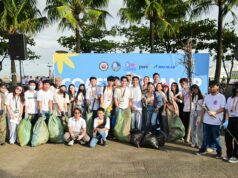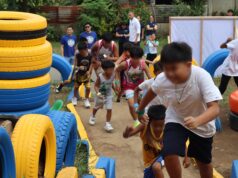SUBIC BAY FREEPORT — The Subic Bay Metropolitan Authority (SBMA) will host the first Subic Bay Water Summit here on January 28-29 to address concerns on the sustainability of this free port’s number one asset — the waters of Subic Bay.
Experts said the 12,350-hectare body of water, which plays a critical role in the development of the Subic Bay Freeport, had been subjected to various strains brought about by rapid urbanization, as well as development activities.
“If these stresses continue, we are sure to be left with an unsustainable resource,” SBMA Administrator Armand Arreza warned.
“Of course, we don’t want that to happen because Subic Bay is an all-important natural asset,” he added.
Arreza pointed out that Subic Bay, which forms part of the communal waters of Olongapo City and nearby areas in the provinces of Zambales and Bataan, is now considered a threatened resource due to patches of pollution load caused by the disposal of partially-treated sewage, nutrient inflows from changes in land use, and inadequate treatment of industrial wastes.
“Surprisingly, despite the growing industrialization in the Subic Bay Freeport, the major culprit in the observed decline of water quality at this point is waste from domestic households in the surrounding local communities,” Arreza added, citing studies made in 2006 during the preparation of the free port’s Integrated Coastal Management Plan (ICMP).
Experts said that as the primary selling point for Subic’s development into a center for investment, commerce, industry and tourism, the bay is being stressed by several sources. These include reduction of forest cover, inefficient use of fertilizer and pesticides, burning of grasslands, proliferation of fish cages, and increasing sewage and pollution load from domestic wastes produced by neighboring communities.
The same studies also revealed that pressures from commercial and industrial activities in nearby communities, as well as rapid urbanization of surrounding communities have also increased solid waste generation.
These stresses are exacerbated by limited sewer and wastewater treatment facilities, and lack of waste disposal facilities despite increases in local population.
In view of this, Arreza said the SBMA decided to call for a summit to involve stakeholders in the Subic Bay Freeport area and local communities in improving the water quality of Subic Bay, and keeping the natural environment healthy, productive and sustainable.
“Since Subic Bay is a common resource, every stakeholder has the moral obligation to keep this critical resource sustainable and we hope that the summit would address this very vital concern,” Arreza added.
SBMA Ecology Center manager Amethya dela Llana-Koval, whose department is spearheading the two-day event, said the SBMA seeks to define the current status and issues on the quality of the environment in Subic Bay through the water summit.
Experts said the 12,350-hectare body of water, which plays a critical role in the development of the Subic Bay Freeport, had been subjected to various strains brought about by rapid urbanization, as well as development activities.
“If these stresses continue, we are sure to be left with an unsustainable resource,” SBMA Administrator Armand Arreza warned.
“Of course, we don’t want that to happen because Subic Bay is an all-important natural asset,” he added.
Arreza pointed out that Subic Bay, which forms part of the communal waters of Olongapo City and nearby areas in the provinces of Zambales and Bataan, is now considered a threatened resource due to patches of pollution load caused by the disposal of partially-treated sewage, nutrient inflows from changes in land use, and inadequate treatment of industrial wastes.
“Surprisingly, despite the growing industrialization in the Subic Bay Freeport, the major culprit in the observed decline of water quality at this point is waste from domestic households in the surrounding local communities,” Arreza added, citing studies made in 2006 during the preparation of the free port’s Integrated Coastal Management Plan (ICMP).
Experts said that as the primary selling point for Subic’s development into a center for investment, commerce, industry and tourism, the bay is being stressed by several sources. These include reduction of forest cover, inefficient use of fertilizer and pesticides, burning of grasslands, proliferation of fish cages, and increasing sewage and pollution load from domestic wastes produced by neighboring communities.
The same studies also revealed that pressures from commercial and industrial activities in nearby communities, as well as rapid urbanization of surrounding communities have also increased solid waste generation.
These stresses are exacerbated by limited sewer and wastewater treatment facilities, and lack of waste disposal facilities despite increases in local population.
In view of this, Arreza said the SBMA decided to call for a summit to involve stakeholders in the Subic Bay Freeport area and local communities in improving the water quality of Subic Bay, and keeping the natural environment healthy, productive and sustainable.
“Since Subic Bay is a common resource, every stakeholder has the moral obligation to keep this critical resource sustainable and we hope that the summit would address this very vital concern,” Arreza added.
SBMA Ecology Center manager Amethya dela Llana-Koval, whose department is spearheading the two-day event, said the SBMA seeks to define the current status and issues on the quality of the environment in Subic Bay through the water summit.




